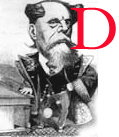Image by the author, who would like to thank Dr. Ruth Richardson, author of Dickens and the Workhouse, which has served as a valuable reference for this brief essay. [You may use this image without prior permission for any scholarly or educational purpose as long as you (1) credit the person who created the image and (2) link your document to this URL in a web document or cite the Victorian Web in a print one.].

Dickens's calling card. It is believed to be the only one of its kind in existence. It is also thought that on this card, Charles Dickens's name appears in printed form for the very first time.

ickens worked at the solictor's office of Ellis and Blackmore as a junior clerk, starting in May of 1827. Because he occupied the lowest rung of the ladder — being just a little older that 15, he found work not very engaging. Consequently, in some of his spare time, young Dickens used a copy of Thomas Gurney's Brachygraphy, or, An Easy and Compendious System of Short Hand (1772), to teach himself that exceedingly difficult skill. Over a period of over a year, he eventually mastered it and decided to try his luck at Doctors' Commons as shorthand writer. He would wait in an area shared by other short-hand writers until a Proctor would engage his services in a trial.
Eventually in Sketches by Boz, New Series, Number 2, Dickens would write about his experiences in the Arches Court and the Perogative Office (where wills were recorded) for the Morning Chronicle (11 October 1836). Likewise relating his own experiences to those of his fictional characters, Dickens in the May 1850 instalment (Part 13) of David Copperfield would show Tommy Traddles helping the protagonist learn shorthand by reading out parliamentary speeches for David to copy (Chapter 38). David is articled as a proctor at Doctors' Commons in the twenty-third chapter of that same novel.
However, at the time, in 1829, that Charles Dickens was learning shorthand, he was still living with his parents and siblings at 10 Norfolk Street over a shop. While at that address, Dickens was ready to take up short-hand writing as an occupation; in consequence, he had a business card printed which reads:
Mr. Charles Dickens, Short Hand Writer, 10 Norfolk Street, Fitzroy Square.
Norfolk street is today known as Cleveland Street and is located West of Tottenham Court Road and South of Euston Road. The Cleveland Street Work House was located a scant eight doors up from Charles Dickens's home.
This is the address that he used when he first took out his reader's ticket at the British Library on February 8th, 1830 — one day after his 18th birthday — the earliest day of eligibility, his 18th birthday, to acquire that ticket. Dickens lived at that address from a time in early 1829 to some time in late 1830.
This was not, however, the first time that Charles Dickens had lived at that address. When John Dickens was transferred to London in late 1814, he and his family took up residence at 10 Norfolk Street in lodgings above Mr. Dodd's grocery. They probably lived there during 1815 and 1816 before they moved to Sheerness and then on to Chatham. Because of employment circumstances and financial difficulties, the Dickens family moved close to two dozen times between Charles Dickens's birth in 1812 and his 22nd birthday in 1834.
References
Ackroyd, Peter. Dickens. London: Sinclair-Stevenson, 1990.
Forster, John. The Life of Charles Dickens. London: Chapman and Hall, 1871.
Richardson, Ruth. Dickens and the Workhouse: "Oliver Twist" and the London Poor. Oxford: Oxford University Press, 2012.
Last modified 22 March 2015